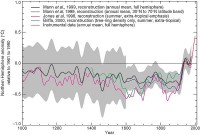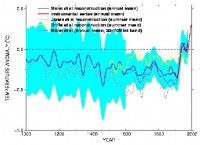By William DiPuccio
The Associated Press has published an independent investigation into the scientific implications of the recent emails hacked from East Anglia University in England. In, “AP IMPACT: Science not faked, but not pretty”, AP writers Seth Borenstein, Raphael Satter, and Malcolm Ritter concluded that “the messages don’t support claims that the science of global warming was faked.”
The Scientific Consensus
But the article misses two very important points and stumbles in its logic. First, regarding the scientific consensus, the reporters conclude: “However, the [email] exchanges don’t undercut the vast body of evidence showing the world is warming because of man-made greenhouse gas emissions.”
The emails, as the article admits, reveal that “skeptical” scientists were stonewalled, blacklisted, and repeatedly denied access to data under the FOI. If the views of these scientists had been welcomed as a check and balance on the work of others, if they had been made partners at the table, if they had been given full access to the same data, if their research was published, and if those who opposed their findings had been forced to respond to their conclusions in peer reviewed literature, then the consensus would probably look much different than it does now.
At the very least, the pretense of utter certainty which proponents of the IPCC hypothesis maintain, would have been substantially diminished and they would have been forced to acknowledge that their position was not fully supported by the peer reviewed literature.
It is circular reasoning to appeal to a consensus that was shaped by scientists conspiring to eliminate all opposition. These scientists, though relatively few in number, wielded a disproportionate influence on the scientific community. Moreover, from the private emails it is evident that they were less confident about their own conclusions than they appeared to be in public discourse.
The Significance of Errors in Past Temperature Reconstructions
Second, the writers of the AP study are totally oblivious to the implications of the attempt by Phil Jones and others to “hide the decline” in a graph that was later published in the 2001 IPCC report. The decline refers to an unmistakable deviation in proxy temperatures derived from tree ring studies. The cause of the deviation has never been resolved. Tree ring proxies are used to reconstruct temperature data for the last 1000 years (instrumental data did not start until around 1850).
Though actual temperatures were rising after 1960, the tree ring data in one major study, by Keith Briffa, indicated that temperatures were falling precipitously. It is clear from the emails that this deviation in proxy temperatures (the “divergence problem") was not disclosed to the public or policy makers because it would raise questions and uncertainties about the overall reliability of past climate reconstructions.
Historical temperature reconstructions are a crucial plank in the IPCC’s hypothesis which claims that our current warming trend is the result of CO2 emissions. If it can be shown that today’s warming is unprecedented, then it is more likely (though not certain) that CO2 emissions are interfering with nature and skewing temperatures upward.
But over the last 1000 years, average temperature has varied by only one degree according to the reconstructions. The case for today’s extraordinary temperatures rides on only four or five tenths of a degree. The large shaded area in the attached graph (from IPCC TAR), which delineates the margin of error, clearly shows the imprecise nature these reconstructions. Briffa’s reconstruction (green line) was truncated at 1960 to “hide the decline.”

2001 IPCC Third Assessment Report (Figure 2.21) comparing different Northern Hemisphere temperature reconstructions from 1000 A.D. to 2000 A.D. The recent instrumental Northern Hemisphere temperature record to 1999 is shown for comparison. Two standard error limits (shaded region) for the smoothed Mann et al. (1999) series are shown. The horizontal zero line denotes the 1961 to 1990 reference period mean temperature. Enlarged here.
Questions raised about the reliability of temperature reconstructions using tree ring data can effectively undermine the claim that our current warming is unprecedented. For example if temperatures in the medieval period were actually closer to the upper portion of the shaded area, as most paleoclimate histories have shown, then there would be no cause for alarm.
The AP investigation was misleading on this particular. The authors tell us that the so-called “hockey stick” reconstruction (shown on the graph) which asserted the 1990s were the hottest years in a millennium, was “upheld as valid” by a National Academy of Sciences study.
But, in fact, there were two studies. The second, conducted by a team of statisticians led by Edward Wegman, chair of the National Academy of Sciences Committee on Applied and Theoretical Statistics, was highly critical of the hockey-stick reconstruction.

A pre-publication draft version of the same graph showing the deviation in Briffa’s reconstruction after 1960 (yellow line). Overall, Briffa’s reconstruction shows a significant departure from the other series. This was apparently adjusted in the final version. Image courtesty of Steve McIntyre, climateaudit.org. Enlarged here.
The AP article never mentioned this investigation. Nor did it mention that in the 2007 IPCC Fourth Assessment, the hockey stick temperature profile was barely discernable. Temperatures in the middle ages were noticeably elevated over those in the 2001 assessment, though still not as high as the current instrumental record.
Contrary to the conclusions drawn by the AP investigation, there are serious scientific implications surrounding the Climategate emails. Though defenders continue to beat the drums in favor of the scientific consensus, it is becoming clear not only that this consensus was partially manufactured through manipulation, but also that the science it represents does not rise to the level of certainty it has auspiciously claimed.
Over the last couple of years, numerous studies have challenged various aspects of the IPCC’s science, including the dominance of CO2. Natural variability - ocean oscillations, solar cycles, etc. - plays a larger role in climate change than once thought. A spate of recent research has shown that aerosol pollution (e.g., soot, sulfur, nitrogen, dust) and changes in land use changes (e.g., deforestation, agriculture, urbanization) have a greater impact on climate than CO2.
Before we pull the trigger and spend billions of dollars on controlling carbon emissions, we need to consider the entire range of scientific research and reassess our policies in light of these findings.
Bill DiPuccio was a weather forecaster for the U.S. Navy, and a Meteorological/Radiosonde Technician for the National Weather Service. More recently, he served as head of the science department for Orthodox Christian Schools of Northeast Ohio. He continues to write science curriculum, publish articles, and conduct science camps.
-----------------------------
See Joe Bastardi on Imus talk about the Triple Crown of Cooling.
--------------------------
See Lord Monckton interview a rather open minded Greenpeace activist here.


